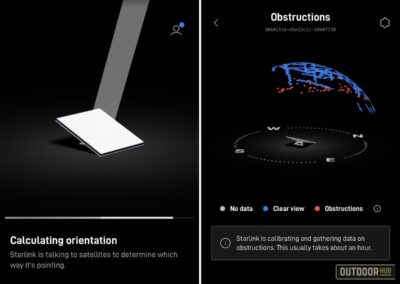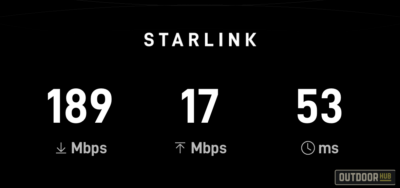
Josh Centers 07.16.25

Elon Musk’s Starlink system is nothing short of a modern miracle. In the past, satellite internet was slow, laggy, expensive, and subject to severe usage caps. But thanks to Starlink’s enormous constellation of satellites, you now have access to affordable, high-speed internet almost anywhere in the world.
The Starlink Mini is a miracle on top of a miracle. The entire “dish” is about the size and shape of a laptop and can easily slip into a backpack. With a Roam plan, you can deploy the Starlink Mini from practically anywhere and get online in minutes. With the Starlink Mini now going on sale for as low as $300, it’s a no-brainer emergency communication system for your hunting pack, camping gear, or your bug-out bag.
However, I returned the first one I bought because I was convinced that it wouldn’t work at my location. That turned out to be a blessing in disguise, because I bought one for $200 less a month later.
Why did I return the Starlink Mini? As miraculous as it is, it still exists in physical reality, and there are certain things to know before you invest.
1. It’s Still Satellite Internet
If you’ve ever subscribed to Dish or DirectTV, you’re already familiar with some of the realities of satellite connectivity. The installer has to get it in just the right position to aim directly at the satellite, without any trees blocking the signal. And if it rains hard enough, no TV for you.
Likewise, if you’ve played with the satellite connectivity features of recent iPhones. You can send a text message via satellite, but the software has to guide you into aiming the phone directly at the satellite as it moves through the sky, and it takes several seconds to even send a short message.
Satellite communications require an open sky for direct line of site to a satellite. Trees, buildings, and other obstacles easily block the signal. And in the case of Starlink, it specifically needs a clear view of the northern sky because the Starlink has to be pointed exactly north for a steady connection.
Unfortunately for me, my farm in Tennessee has a big, wooded hill on the north side. That means there are only a handful of spots where I can get a clear enough view for a steady connection, and even then there are frequent interruptions. Fine for web browsing, but frustrating for Zoom calls.
The Starlink phone app gives you tools to view obstacles. There is a Check for Obstructions feature that lets you can the sky with your phone to determine if it’s a good spot for your Starlink. The Starlink also maps out obstructions over time, and the app displays a 3D map of the coverage.

2. No Speed Tests Unless You Pay
My home coverage is bad, but I thought it was worse than it actually is. An unactivated Starlink can connect to the Starlink website, but nothing else. That includes the speed test built into the app.
The reason I returned my first Starlink Mini is because the speed test kept failing. I assumed it was due to obstructions when in fact it was just that the speed test server isn’t whitelisted for dishes that haven’t been activated.
Once I finally ponied up, I actually saw speeds greater than the advertised speed of 100 Mbps, pushing toward 200 Mbps—faster than my home fiber optic internet.

3. You’re Not Stuck with a Monthly Bill
The standard Starlink Roam plan is $50 per month for 50 GB of data, and you will have to pay for one month of that service to activate the hardware. However, as soon as you do that, you can pause your billing—you’ll have Starlink service until the end of your current billing period, but you won’t be charged again until you reactivate it.
You can also switch over to a $10 per month plan, which includes 10 GB of data. Alternatively, there is an unlimited plan for $165 per month.
On the 50GB plan, each additional GB of data costs $1, and it costs $2 per GB on the 10GB plan.
4. Not Just Any Battery Will Power It
One of the draws of the Starlink Mini is that you can deploy it anywhere, but you still need a power supply. As I found in my testing, not just any power supply will do. I purchased a USB-C power cable from Starlink with the intention of connecting it directly to my Jackery 160’s USB-C port. Alas, it didn’t work. The Jackery only puts out 30W max via USB-C while the Starlink Mini requires at least 65W, preferably 100W. However, I did find that I could use the standard AC adapter with the AC plug on the side of the Jackery.
However, something like the Jackery Explorer 1000, with a 100W USB-C port, would work, as would any of the growing collection of 100W power banks on the market.
In any case, I definitely recommend ordering the car adapter and USB-C cable from Starlink to maximize your portable power options.
5. The Built-in Router is Weak
What makes the Starlink Mini so cool is it’s an all-in-one package. A single device that resembles a piece of paper grabs internet from space and turns it into Wi-Fi. However, that form factor comes with some drawbacks. Because the router is so small, it’s also pretty weak. Don’t expect it to penetrate far into buildings.
However, the good news is that you can connect an external router to it via an Ethernet cable and put the Mini into bridge mode to expand the Wi-Fi coverage. Note that you shouldn’t just just any Ethernet cable, but one designed for the Starlink Mini with a ribbed plug that will keep water out of the port.
All this is to say that you shouldn’t buy the Starlink Mini expecting it to replace your home internet connection: The plans are pricier and the hardware isn’t as robust as the Standard Kit. However, for what it’s designed to do—provide mobile internet anywhere in the world–it’s unbeatable.
Trending Products












